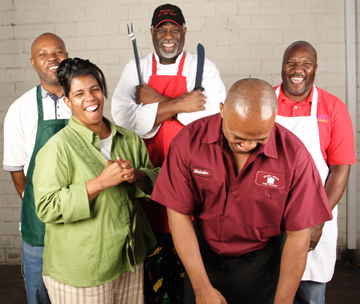 “Those workers remembered the lunch they had that day,” recalled her nephew Malcolm Houston. “They came back the next day and the next week. They started bringing their friends. Pretty soon, word began to spread all through city government.”
“Those workers remembered the lunch they had that day,” recalled her nephew Malcolm Houston. “They came back the next day and the next week. They started bringing their friends. Pretty soon, word began to spread all through city government.”
Specifically, the word spread upward — all the way to the city council and the mayor’s office. Louise King cooked for various mayors and many city council members throughout the ’80s and ’90s. She became good friends with philanthropist Bill Meadows. She never charged outright for her meals, but did accept what she liked to call “love donations.” By the time of her death in the summer of 2005 at age 78, “Mama Lou” was the acknowledged culinary patron saint of Como, with a reputation that extended beyond the West Side into the mayor’s office, corporate boardrooms, and newspaper offices.
Three of the earliest fans of her food were nephew Houston and fellow Como natives Drew Thomas and Leroy Wilson. The trio went through school together as casual friends from Como Elementary through Como High School and graduated, post-desegregation, from Arlington Heights.
Decades later, the three are central figures in what is becoming a critical mass of cafés near the corner of Horne Street — Como’s longtime central thoroughfare — and Camp Bowie Boulevard, on the border between the historic black neighborhood and the affluent, mostly white parts of the West Side. Over the last five years, these independently owned restaurants — A Taste of Soul, Mama Lou’s, and Wilson’s BBQ — have joined longtime home-cooking joint Drew’s Place to create a kind of Soul Food Central for the Como area. Just a short skip up Camp Bowie from the Horne intersection is the new, wildly popular “upscale soul food” joint known as Ovation. While there are some differences among them, they all operate under that umbrella known as comfort food — Pavlovian chow such as smothered pork chops, beef ribs, barbecue, and fried chicken and waffles, the fare that soothes your spirit even as it collects around your waist.
As ripples of a nascent renaissance make their way through Como — property values are rising, new homes are being built, high-dollar retail-residential developments have mushroomed along its borders — few may have noticed that the mom-and-pop establishments of this comfort-food corner are gradually working their own change, drawing in significant crowds of white-collar, often Anglo professionals from all over the city, folks who’ve discovered over the past few years that just blocks away from the retail mecca of Camp Bowie is a small oasis of naughty gustatory delights that fly in the face of nutritional fiats to cut your fat, salt, and starch intake.
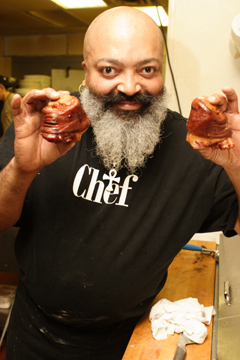 Even as the big players are promising to revitalize Como, the little guys of this Westside black-run café strip are creating a destination spot where people from outside the neighborhood are coming to fill their bellies. As Keith Hicks of Ovation put it, these are places “where all different kinds of people can come together and break bread.”
Even as the big players are promising to revitalize Como, the little guys of this Westside black-run café strip are creating a destination spot where people from outside the neighborhood are coming to fill their bellies. As Keith Hicks of Ovation put it, these are places “where all different kinds of people can come together and break bread.”
Longtime Como resident and advocate Dorothy DeBose gets a glowing tone in her voice when she talks about Horne Street and the neighborhood that surrounds it.
“I used to walk up and down Horne with my friends on weekend nights, and we’d just wave at the other kids walking by,” she said. “My father owned a grocery store and eat[s] shop on the street that our neighbors shopped at.”
These days, she’s apt to get a warm feeling in her insides as well, when she considers the popular cluster of cafés on that street. DeBose regularly partakes of the delicacies offered there.
She knows the restaurant business is fickle and independent ownership is tough; except for Drew’s Place, the establishments are anywhere from six months to four years old — not enough time to elevate them to the level of institutions. But she does think they bode well for her beloved Como. “What you see is a neighborhood that still has the strength to strive toward bettering itself,” she said. “That means we have hope.”
That hasn’t always been the case around here. As with so many thriving black communities of the mid-20th century, the law of unintended consequences was triggered in Como after desegregation occurred during the ’60s and ’70s: Businesses closed, and the neighborhood fell into disrepair because African-Americans were no longer limited to patronizing their own.
Community activists like DeBose, working in concert with committed city council members, are one of the reasons people can look to Como’s future with anticipation. The neighborhood celebrated its centennial last year with speeches, banners, and events. Spiffy new brick homes have recently been purchased for prices ranging from $80,000 to $200,000. This can indirectly be attributed to all the high-dollar developments on Bryant Irvin Road and other areas along Como’s borders — black professionals who grew up in Como are beginning to return and buy those brick houses because they see vitality in that part of the West Side.
But nobody wants to jinx future prosperity by overestimating current success. For now, the restaurateurs of Horne Street are just working hard to make their businesses survive and thrive — building on one another’s achievements while hewing to their own versions of the food that some of them learned to make within a few blocks of their current establishments.
Mama Lou’s will celebrate its second anniversary next month. Louise King didn’t hand over her preciously guarded recipes until near the end of her life, when, her nephew said, “she heard there was going to be a building with her name on it.” Too frail to cook by that time, she nonetheless served as coach, patiently watching as Malcolm Houston learned to prepare her smothered chicken, meatloaf, pork chops, and cabbage with bacon. She even agreed to make certain adjustments so her food was less greasy and salty, for the contemporary, health-conscious crowd.
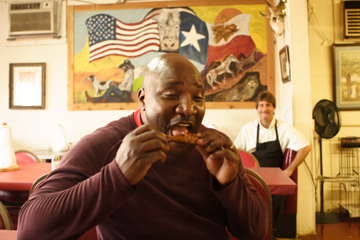 Wilson and Thomas have fond memories of Mama Lou, although they say she had no direct influence on their decision to open restaurants. They insist they came by their passions for cooking independently — Wilson learned a lot about smoking meat from his father before he opened Wilson’s BBQ four years ago, and Thomas’ mother had turned him into a proficient chef by the time he was a teenager.
Wilson and Thomas have fond memories of Mama Lou, although they say she had no direct influence on their decision to open restaurants. They insist they came by their passions for cooking independently — Wilson learned a lot about smoking meat from his father before he opened Wilson’s BBQ four years ago, and Thomas’ mother had turned him into a proficient chef by the time he was a teenager.
Thomas puttered around various Fort Worth kitchens before he opened the first location of Drew’s Place back in 1987. He classifies his first 10 years as “just hanging in there”; the second decade proved more fruitful as new businesses around Camp Bowie and Horne began to draw larger crowds — and, of course, as the other Horne Street eateries turned their “Open” signs to the window.
The idea that Como has a “Soul Food Central” has been imposed from the outside — that nickname is not commonly used among Como-ites. Still, it’s helpful for stirring discussion — including about what exactly soul food is.
Some would say “soul food” is a generic label that Anglos place on any home-cooking done by African-Americans. Not surprisingly, there are a variety of opinions eagerly offered by the entrepreneurs of Horne Street.
Shawn and Stanley Johnson, 38 and 43 respectively, are the newest kids on the block. This married couple opened A Taste of Soul on Horne Street just this past August. She’s the owner, he’s the chef. As the name of their establishment suggests, they embrace the phrase “soul food.” Though they serve many of the same items as several of the nearby eateries — catfish, chicken, pork chops, collard greens — Shawn insists that anything with a calming, savory flavor that “talks to your soul” can be considered soul food. Shawn is a native Texan; Stanley hails from Louisiana. He finally agreed to become a professional chef after she bugged him for years — the compliments he received from catering church functions were too frequent and effusive to ignore.
“I cook with my soul,” Stanley said. He also puts his share of time and sweat into the process, getting up at four o’clock every morning to start the day’s menu from scratch. That means the chili beans he mixes with the collard greens get simmered a long time, as well as the “30-weight” gravy (so-called because it must achieve a certain thickness) and the beef tips. They also serve chitlins and black-eyed peas on occasion—perhaps a more classic “soul food” combination.
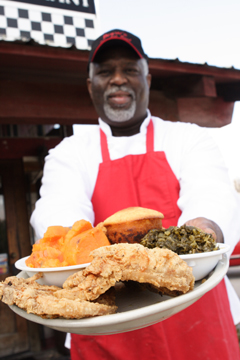 Keith Hicks of Ovation on Camp Bowie has a stricter, historical definition. The 43-year-old Hicks, former kitchenmeister at Cachonga’s and a native of West Virginia, doesn’t really care what you call his food as long as you stop by to eat it. But if you want to get specific, “‘Soul food’ is something that came from the slave days,” he said. “If you were a slave, you might not get your hands on a whole live pig very often. You’d get whatever the masters threw out of their kitchens — the entrails, the feet, the ears. And then you had to do your best to make this stuff taste good. You had to put ‘soul’ into the leftovers.”
Keith Hicks of Ovation on Camp Bowie has a stricter, historical definition. The 43-year-old Hicks, former kitchenmeister at Cachonga’s and a native of West Virginia, doesn’t really care what you call his food as long as you stop by to eat it. But if you want to get specific, “‘Soul food’ is something that came from the slave days,” he said. “If you were a slave, you might not get your hands on a whole live pig very often. You’d get whatever the masters threw out of their kitchens — the entrails, the feet, the ears. And then you had to do your best to make this stuff taste good. You had to put ‘soul’ into the leftovers.”
Houston agrees. And because he agrees, he rejects the label “soul food” for the fare he serves at Mama Lou’s. He prefers “comfort food.” “A lot of so-called ‘soul food’ is nasty,” he said bluntly. “Taking a raggedy piece of pork and dipping it in lard does not make it taste better. It’s just bad for you.”
Leroy Wilson doesn’t make soul food. Nor does he call it “comfort food” or “home-cooking,” even though he mastered the art of smoking and grilling meat at the house. His specialty can be called nothing else but barbecue. His voice begins to bliss out as he discusses it: For him, barbecue is an institution, a way of life, a state of consciousness. It reaches across race, age, economic class, and gender.
“Let me put it this way,” he explained. “If your friends know you know how to barbecue, you can dig a hole in your backyard to cook it and they’ll come running. Ain’t nobody gonna eat meat loaf or collard greens out of a hole you dug in your backyard.”
If you’ve visited a crowded Fort Worth mall this holiday season, you know that all those MDs who’re pestering us about our eating habits are pretty much right: The average American ass is swelling in inverse proportion to the dramatic shrinking of the polar ice caps. The problem with comfort food is that it can make you too comfortable, too willing to rest for hours on the couch in the evening when your only exercise is operating the Tivo remote.
Still, many people are indeed making healthy changes to their dietary habits. That would presumably spell bad luck for folks who sell various combinations of fried catfish, potato salad, spicy sausage, brisket, buttered cornbread, and mashed potatoes slathered with brown gravy. Right?
Well, it hasn’t been a problem so far at Horne and Camp Bowie. None of the restaurateurs there noticed any kind of dent in their daily traffic during the recent low-carb diet fad. Drew Thomas did relate one great anecdote about a certain Como couple who’d officially agreed to lose weight together — and then came in separately “and would say, ‘Shh, don’t tell my wife I’m here, don’t tell my husband I’m here,’” Thomas recalled with a laugh. It seems that they were both cheating on each other with Drew.
Hicks, for one, thinks his patrons are smart about the way they select and organize their daily meals.
“For sure, a cat wouldn’t want to eat this stuff every day,” he said. “You wouldn’t be making any Subway commercials if you did that. But there’s a time and a place for everything, and people know that. And most of us prepare our meals” with healthy details in mind. For example, he uses smoked turkey legs to season his greens rather than ham hocks, to cut the fat grams.
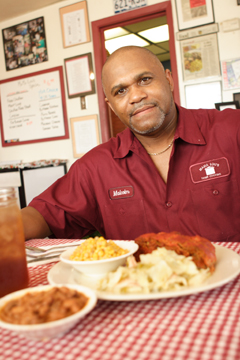 Malcolm Houston uses ground chuck rather than regular ground beef for Mama Lou’s meat loaf because it’s significantly leaner. Houston thinks in some ways he’s benefited from all the media scoldings about nutrition: Since the majority of his clientele come from out of the area, he thinks his restaurant has become a destination spot for folks who’re ready to splurge.
Malcolm Houston uses ground chuck rather than regular ground beef for Mama Lou’s meat loaf because it’s significantly leaner. Houston thinks in some ways he’s benefited from all the media scoldings about nutrition: Since the majority of his clientele come from out of the area, he thinks his restaurant has become a destination spot for folks who’re ready to splurge.
“The food [at Mama Lou’s] is not as big a deal to many of the people who live in Como, because a lot of them know how to cook it themselves. They’ll swing by to pick up dinner when they don’t feel like making it themselves,” he said.
Which raises the question: Who are the regulars who have kept these establishments afloat in fat times and lean? The universal answer seems to be that an increasing number of white people have discovered that, if they take a left turn on Horne while traveling southwest on Camp Bowie from I-30, they’ll discover a quiet but vibrant restaurant district that hasn’t yet appeared in the Zagat national survey.
In the hustle and bustle of opening Ovation, Hicks has had just enough spare time to sample meals at Drew’s Place and A Taste of Soul. He relishes the fact that there are active railroad tracks on the south side of Como: It offers a metaphor for the two different worlds that are beginning to merge. “It’s the old, romantic story of the wrong side of the tracks vs. the right side of the tracks,” he declared. “This [Horne and Camp Bowie] is an intersection where the wrong side and the right side get together.”
In other words, this is a strip where Fort Worth’s black and white communities increasingly intermingle to enjoy food cooked by individuals who don’t really care who you are or where you’re from, as long as you’re willing to sit down and dig in. But as high-priced condos, houses, and corporate headquarters become more numerous along the neighborhood’s edges and their owners more curious about Como, the folks who show up become paler and more affluent.
As far as patron demographics, Houston said flatly that, at Mama Lou’s, “Ninety percent of our customers are white, and 80 percent of those customers have a lot of money.” Mama Lou’s continues to attract the business and city government crowd that Louise King drew, to the extent that the restaurant recently catered meals for Mayor Mike Moncrief and a city council meeting. Indeed, Houston confirmed that they are currently scouting locations outside of Como to open a second Mama Lou’s.
City planning director Fernando Costa said that what the Horne Street cafés are experiencing is nothing new. “Places like Horne Street on the West Side and Evans Avenue on the Southeast Side have usually experienced revivals when outsiders came in to enjoy their goods and services,” he said. “Even during segregation, Anglos would come to Como for things that they couldn’t get in their own neighborhoods.”
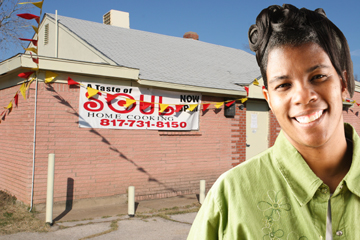 Leroy Wilson admits that, after four years in business, he still sees dramatic variations in the number of people who walk through the door. Wilson’s BBQ seats around 65 diners. Some days, it’s packed, and others — eh, not so much. “I think people like to eat with crowds,” he lamented. “Or at least, if they come in and don’t see a crowd, they think, ‘The food must not be good here.’” He does confirm that he’s seen a gradual but fairly dramatic rise in the number of Anglo regulars from the surrounding areas since he hung out his sign.
Leroy Wilson admits that, after four years in business, he still sees dramatic variations in the number of people who walk through the door. Wilson’s BBQ seats around 65 diners. Some days, it’s packed, and others — eh, not so much. “I think people like to eat with crowds,” he lamented. “Or at least, if they come in and don’t see a crowd, they think, ‘The food must not be good here.’” He does confirm that he’s seen a gradual but fairly dramatic rise in the number of Anglo regulars from the surrounding areas since he hung out his sign.
Open less than six months, A Taste of Soul is still developing its clientele. Shawn Johnson and Stanley Johnson are both devout Christians, and Shawn said that their establishment has “a Christian atmosphere”: Gospel music c.d.’s play alongside the hissing sound of the simmering sauces. “We wanted to target the Sunday crowd, the after-church people,” she said, and so far they remain A Taste of Soul’s most faithful constituency. She estimated that 90 percent of her diners are African-American and Como dwellers, who’ve found the place mostly through word of mouth generated in the pews. Everyone is welcome, she hastened to add, and she hopes eventually to see a more varied crowd seated at her tables.
In his position over on “the right side of the tracks,” Keith Hicks at Ovation said he sees a pretty good mixture of working-class Como-ites as well as white-collar downtown loft dwellers. One has to wonder, as Houston does, how prohibitive a $13 price tag for chicken and waffles is for some folks. Hicks defends his upscale approach to comfort food, his love of presentation and experimental flavors, and his prices with a statement of simple confidence: “No one makes chicken and waffles like I do.”
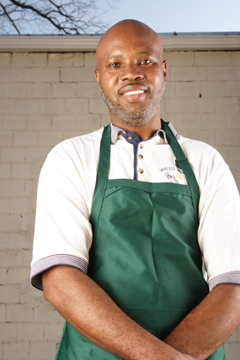 Hicks agreed that there are differences in black and white attitudes about food. He said, “If you’ve got a family of six kids, and parents working two jobs and still not pulling in enough income, then there’s gonna be a fight when someone opens the refrigerator and wants to know: ‘Who ate my baloney and cheese?’” His implication is that poor blacks may grow up less diet-neurotic and more appreciative of the food they have than whites with well-stocked fridges.
Hicks agreed that there are differences in black and white attitudes about food. He said, “If you’ve got a family of six kids, and parents working two jobs and still not pulling in enough income, then there’s gonna be a fight when someone opens the refrigerator and wants to know: ‘Who ate my baloney and cheese?’” His implication is that poor blacks may grow up less diet-neurotic and more appreciative of the food they have than whites with well-stocked fridges.
In the end, though, Hicks believes it’s more about economics than race: “You’re asking me if it’s a color issue? Yeah, it is, and that color is green. The cats at the top have us all fighting about our different skin colors while they take in all the green.”
For her part, DeBose doesn’t want to oversell the idea of a wholesale revival of Horne Street fueled by the eateries that seem to be attracting more and more outsiders. By the standards of the restaurant industry, only the 20-year-old Drew’s Place has proven it can weather the vagaries of time and fickle taste. These are, after all, small, independently owned ventures that still sit largely in the shadows of the chic shops, bistros, and coffeehouses that line Camp Bowie.
These are her priorities: First, she just wants to make sure A Taste of Soul has peach cobbler on hand when she calls and asks them to save her a piece. Next, she notes that the significance of Horne and Camp Bowie’s emerging restaurant district is the victory of black-owned businesses hiring and serving other blacks from within their own community — just the way her father did when he operated his small grocery/restaurant on Horne Street decades ago. An emerging influx of Anglo professionals who dine here, she said, is gravy — pun intended.
You can reach Jimmy Fowler at jimmy.fowler@fwweekly.com.











